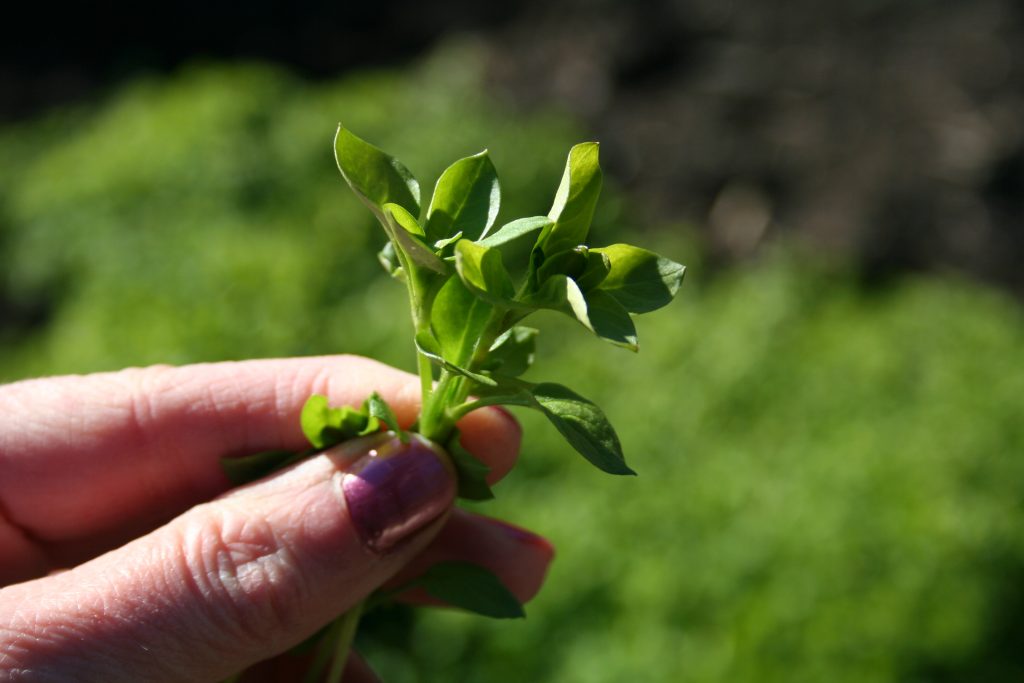Identifying garden weeds is the first step to removing noxious weeds from your lawn and garden. Like plant identification, weed identification starts by examining the weeds in question, matching them through pictures and characteristics, then determining what to do about removing them.

Garden Weed Identification
Plant or Weed?
The first step to garden weed identification is knowing whether or not the plant in question is a weed or something you’ve planted.
I know this sounds silly. After all, who doesn’t know what they planted in the garden?
Newly emerging seedlings and perennials often look like other plants or like emerging garden weeds. One reason why I encourage readers to use plant markers or stakes to mark all of their flowers and vegetables is to prevent accidentally pulling up a wanted plant by confusing it with a weed.
Look Closely at the Plant
A pundit wrote, “Weeds are simply plants no one wants” and truer words were never spoken. Sometimes weeds provide useful properties such as edible weeds like dandelion and chickweed. At other times, they invade the garden and strangle existing plants, using vital resources such as water and soil nutrients. Crabgrass comes to mind.
To identify garden weeds, notice several characteristics about it:
- Does it look like a lawn grass but it’s growing in a flower or vegetable bed? Chances are it may be a grassy weed such as Johnson grass, crabgrass, or wire grass.
- What is the leaf shape? Leaf shape can tell you a bit more about the plant. Leaves can be rounded, pointed, serrated, or toothed.
- Notice how the leaves grow on the stem. Do they grow in groups of three, four, five or more? Are they opposite each other or staggered along the stem?
- Take a picture of the plant in question. I use Google’s reverse image search to gather close matches. You won’t get an exact match, but you can sometimes get a close match. (Sometimes the results are poor, but it’s computer-driven picture identification – you need to apply human smarts to it to get a closer match).
- Compare your findings to the many weed identification books and guides available online and in print.
Garden Weed Identification Websites
Once you have a good idea of the plant’s characteristics and a picture or two of the weed, it’s time to go on the hunt for a match. Weeds vary according to where you live. Some weeds are common throughout much of the United States but others are specific to arid regions, shore regions, mountainous regions, etc. That’s why using your local cooperative extension website is so important to weed and plant identification efforts.
A few good sites I like to use for weed identification include:
Weed Alert – Search by region for your weeds. The site includes plenty of pictures to help you with your match.
The Old Farmer’s Almanac – Another great resource for garden weed identification with plenty of color pictures.
Preen – Yes, Preen is a chemical company and they want to sell you products to kill weeds in your lawn and garden beds. They do have a great website that lets you look up weeds by state with excellent photographs.

Rocky, one of my cats, helps identifying garden weeds. Dandelion, crabgrass and clover are all in this picture.
Why Bother with Identifying Garden Weeds?
Now, the question you may be wondering – Why bother with weed identification? After all, if you’re pretty sure it’s a weed, just pull it or kill it, right?
Yes and no. Understanding which weeds are growing in your lawn and garden enables you to take a scientific, accurate approach to weed control.
Some weeds respond best to pulling them up. Others may need several methods such as pulling the weeds by hand and spraying either chemical or organic herbicides to control seedlings.
For example, some weeds such as dandelions have a very long taproot. Dandelion taproots can grow as long as 12 feet into the subsoil. If you don’t get the taproot out, the dandelion will return.
Chickweed, another common garden weed, grows in thick, dense mats in moist areas. It dies back by itself in the warm weather but revives in sprint and fall. Pulling it by hand before it seeds is the best way to remove it. If you try to spray it, you’ll end up dumping chemicals on a large section of the garden. The seeds live for a long time and can remain dormant in the soil. Therefore, spraying it along either with chemical or organic weed killers doesn’t truly kill it. Henbit also dies back in the heat.
Know Your Noxious Garden Weeds
Know your noxious weeds, too, so that you can avoid painful, itchy rashes. Poison ivy, poison oak, poison sumac and relatives all grow in many areas. I have poison ivy invading the pet cemetery here at Seven Oaks. That gets sprayed with herbicide; we can’t pull it by hand.
Juniper may not be considered a weed, and you may have juniper bushes growing in your yard. I have invasive wild junipers that pop up in all sorts of unexpected places. I am among the 20-30% of the population sensitive to junipers and get a nasty rash on my arms when I try to pull out the seedlings. I have to wear gloves and long sleeves and wash carefully with soap and water after encountering juniper. (The rash does go away in about 12-24 hours on its own, but it sure itches).
These and other noxious weeds aren’t going to kill you or make you seriously ill if you touch them casually but can give you an awful rash that may make your life miserable for weeks to come. Learn what each looks like and never pull weeds without a sturdy pair of gardening gloves.




